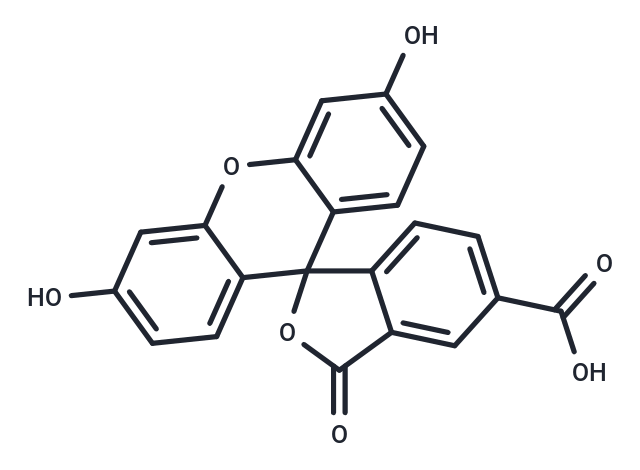Shopping Cart
Remove All Your shopping cart is currently empty
Your shopping cart is currently empty
5-FAM (5-Carboxyfluorescein) (5-Carboxyfluorescein) contains a carboxylic acid, which can be used to react with primary amines via carbodiimide activation of the carboxylic acid. Fluorescein is the most common fluorescent derivatization reagent for labeling biomolecules. In addition to its excellent fluorescence quantum yield, relatively high absorptivity, and good water solubility, it also has an excitation maximum that closely matches the 488 nm spectral line of the argon-ion laser.

| Pack Size | Price | USA Warehouse | Global Warehouse | Quantity |
|---|---|---|---|---|
| 50 mg | $33 | In Stock | In Stock | |
| 100 mg | $47 | In Stock | In Stock | |
| 1 mL x 10 mM (in DMSO) | $50 | In Stock | In Stock |
| Description | 5-FAM (5-Carboxyfluorescein) (5-Carboxyfluorescein) contains a carboxylic acid, which can be used to react with primary amines via carbodiimide activation of the carboxylic acid. Fluorescein is the most common fluorescent derivatization reagent for labeling biomolecules. In addition to its excellent fluorescence quantum yield, relatively high absorptivity, and good water solubility, it also has an excitation maximum that closely matches the 488 nm spectral line of the argon-ion laser. |
| Cell Research | Instructions 1. Preparation and storage a. Solubility: 5-FAM is usually provided in powder form and is easily soluble in DMSO, DMF, or aqueous solution with pH ≥ 8. b. Recommended stock solution concentration: 10–100 mM (adjusted according to experimental needs). Before use, it is recommended to prepare with anhydrous solvent and dispense in small volumes to avoid repeated freezing and thawing. 2. Biomolecule labeling (such as proteins, nucleic acids) a. Activation reaction: 5-FAM is usually combined with an activation reagent (such as EDC/NHS) to generate active esters to facilitate reaction with the amine group of the target molecule. b. Amine-free neutral buffer (such as MES or PBS, pH 6–8) is recommended for the reaction buffer. c. Binding step: Mix the active ester with the target molecule and react at room temperature for 1–2 hours. Optimize the pH and reaction time if necessary. d. Purification: Use dialysis or gel filtration to remove unreacted 5-FAM. 3. Fluorescence imaging a. Sample preparation: dilute 5-FAM to working concentration (usually 1–10 µM). b. Directly apply or incubate cells or tissue for 10–30 minutes, followed by washing with PBS to remove unbound dye. c. Microscope observation: Excitation wavelength: ~495 nm. Emission wavelength: ~520 nm (green fluorescence). |
| Synonyms | 5-Carboxyfluorescein |
| Molecular Weight | 376.32 |
| Formula | C21H12O7 |
| Cas No. | 76823-03-5 |
| Smiles | OC(=O)c1ccc2c(c1)C(=O)OC21c2ccc(O)cc2Oc2cc(O)ccc12 |
| Relative Density. | 1.73 g/cm3 (Predicted) |
| Color | Yellow |
| Appearance | Solid |
| Storage | keep away from direct sunlight,keep away from moisture | Powder: -20°C for 3 years | In solvent: -80°C for 1 year | Shipping with blue ice/Shipping at ambient temperature. | ||||||||||||||||||||||||||||||
| Solubility Information | DMSO: 30 mg/mL (79.72 mM), Sonication is recommended. | ||||||||||||||||||||||||||||||
Solution Preparation Table | |||||||||||||||||||||||||||||||
DMSO
| |||||||||||||||||||||||||||||||
| Size | Quantity | Unit Price | Amount | Operation |
|---|

Copyright © 2015-2026 TargetMol Chemicals Inc. All Rights Reserved.